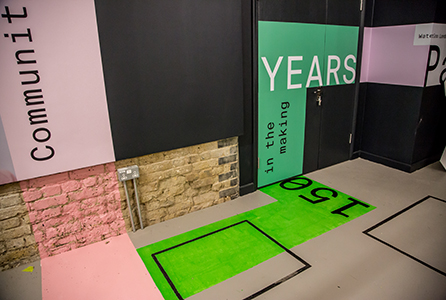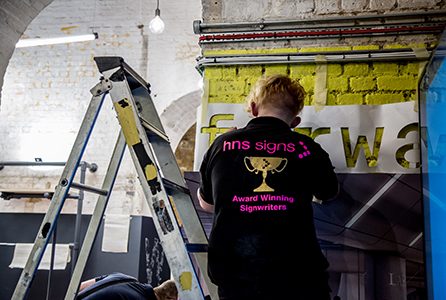A truly tricky sign-writing task
As part of ambitious plans by London Central Rail to transform its estate, HNS Signs was called in to help with a challenging project involving London Waterloo.

Monday, 21 Oct 2019 14:27 GMT

The HNS Signs team were faced with old, crumbling brick walls
Identity Signs London and marketing agency Chocolate were approached to transform the historic site using the concept: “The past gave Waterloo its character. The future has infinite potential. Great choices are made in the now”.
Using this brief, the companies came up with an idea to create a room from the past, one for the present, and one representing the future with a timeline incorporated to connect them all.
HNS Signs was brought in to help with the sign-writing aspect, which Michelle Henry, managing director of the firm describes as “having a few curve balls”.
Henry’s great-grandfather was a sign-writer, as are her two brothers so the traditional technique well and truly runs in the family. It was this experience that led Henry to flag up some potential problems in the initial design.

Our usual tools of the trade and tape were not going to help. The tape failed to stick in most places and the chalk wouldn’t stick”
She explains: “On day one, we knew from experience our initial ‘simple’ project was going to need more thought. The original, approved and provided artwork was incorrectly scaled and the walls were not suitable to sign paint – they were damp and in appalling condition.
“When touched with a talc cloth, the wall merely crumbled away. Our usual tools of the trade and tape were not going to help. The tape failed to stick in most places and the chalk wouldn’t stick. Trying to pounce or draw over the trace made the walls crumble. Instead, we had to cut out the letters to create a stencil and use an extra soft nib pen to mark it out.
“Using our mathematical skills, we amended the scale and started to work by hand, memory, a keen eye and a bit of luck until the revised artwork was delivered over a day and half later.”

The project combined sign-writing with digital print
In addition to tackling the tricky environment of the walls, HNS Signs was also asked to paint the floor in keeping with the timeline theme. Henry explains how this was also no mean feat. Expecting it to be cork, the team arrived to find it was in fact vinyl and concrete, which led to a trip to the local decorator’s store to find a specialist primer.
Reflecting on the ceiling section, Henry continues: “The ceiling artwork may not be as breath-taking as the Michelangelo Sistine Chapel, but the same approach and skill-sets were needed. Working at heights and at very uncomfortable levels, we certainly produced urban, modern art even the classic painters would be proud of.
“This was made far more complicated by big chunks of paint dropping off the ceiling and onto our faces as we worked. We soon learnt to keep our mouths shut whilst doing this part. We had to use paint pens to sharpen up lettering as the wetness of actual paint caused more paint to come loose.”

This was the hardest sign-painting project that we have had to date. The tight timescales, brick conditions and busy site really made this challenging”
After tackling the sign-writing aspect of the challenge, the team moved on to the digital print part. Henry explains that this was also more complicated than expected.
The digital print section had to line up perfectly with HNS Signs’ sign-writing section and Henry describes how some areas had already been fixed into place by the time the team arrived.
She says: “We had to adapt to this as well as the incorrect scale. A lot of the artwork had to be flexible to overcome areas where the original design just wouldn’t work as the wall was in too bad a condition from broken brick work or excessive damp.”

The team opted for stencils as the surface proved too tricky to paint free hand
Summing up the project, Henry says: “This was the hardest sign-painting project that we have had to date. The tight timescales, brick conditions and busy site really made this challenging. Working weekends was also a no no, as the end-client has strong family values and would not allow it.”
Despite these challenges, Henry praises Identity Signs for being “amazing to work with” and adds: “It’s not often that we meet others as adaptable as ourselves. They are real problem solvers.”
The project took a total of 154 hours of on-site work, and an additional 12 hours of preparation work was involved.
If you have any news, please email carys@linkpublishing.co.uk or join in with the conversation on Twitter and LinkedIn.